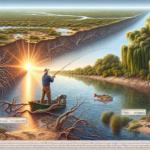Fishing in the Gulf of Mexico: From Texas to Florida’s Panhandle

Introduction
Did you know that the Gulf of Mexico is home to over 1,500 species of fish, making it one of the most diverse fishing destinations in the world? From the bustling shores of Texas to the serene beaches of Florida’s Panhandle, the Gulf offers a plethora of opportunities for anglers of all skill levels.
This article will explore the rich fishing culture of the Gulf of Mexico, focusing on the stretch from Texas to Florida’s Panhandle. We will delve into the best fishing techniques, species information, top fishing spots, seasonal considerations, and more. Whether you are a seasoned angler or a novice looking to cast your first line, this guide will provide you with all the information you need for a successful fishing trip.
Understanding the intricacies of fishing in this region is crucial for maximizing your experience. From knowing the best times to fish to understanding local regulations, this guide aims to equip you with the knowledge to make your fishing adventure both enjoyable and sustainable.
Background/Context
Historical or Cultural Significance
Fishing has been a vital part of the Gulf of Mexico’s culture and economy for centuries. Indigenous tribes, such as the Karankawa in Texas and the Calusa in Florida, relied heavily on fishing for sustenance. Today, the Gulf remains a cornerstone of local economies, supporting commercial and recreational fishing industries that generate billions of dollars annually.
Geographical Overview
The Gulf of Mexico is a large ocean basin bounded by the United States, Mexico, and Cuba. The region from Texas to Florida’s Panhandle features a diverse range of ecosystems, including estuaries, coral reefs, and mangroves. The climate is generally warm and humid, with mild winters and hot summers, making it an ideal year-round fishing destination.
Key Points/Details
Fishing Techniques
Technique Overview
Several fishing techniques are popular in the Gulf of Mexico, including:
- Bottom Fishing: Ideal for catching species like snapper and grouper.
- Trolling: Effective for targeting pelagic species such as kingfish and mahi-mahi.
- Fly Fishing: Popular in shallow waters and estuaries for species like redfish and speckled trout.
When and Where to Use
Bottom fishing is best in deeper waters near reefs and wrecks, while trolling is effective in open waters. Fly fishing is most productive in shallow flats and estuaries. The best seasons vary by species, but generally, spring and fall offer optimal conditions.
Recommended Gear
- Bottom Fishing: Heavy-duty rods and reels, braided line, and live or cut bait.
- Trolling: Medium to heavy rods, trolling reels, and artificial lures or live bait.
- Fly Fishing: Lightweight fly rods, floating lines, and a variety of flies.
Species Information
Species Overview
The Gulf of Mexico is home to a wide variety of fish species, including:
- Red Snapper: Found near reefs and structures, especially during summer.
- Speckled Trout: Common in estuaries and shallow waters, particularly in spring and fall.
- King Mackerel: Often caught while trolling in open waters, especially in warmer months.
Best Practices
To successfully catch these species, consider the following tips:
- Red Snapper: Use live bait and fish near reefs or wrecks.
- Speckled Trout: Employ light tackle and artificial lures in estuaries.
- King Mackerel: Troll with live bait or artificial lures in open waters.
Location Information
Top Fishing Spots
Some of the best fishing spots in the Gulf of Mexico include:
- Galveston, Texas: Known for its diverse fishing opportunities, including offshore and inshore fishing.
- Destin, Florida: Famous for its clear waters and abundant fish populations.
- Port Aransas, Texas: Offers excellent opportunities for both deep-sea and bay fishing.
Regulations and Licenses
Fishing regulations vary by state and species. Anglers must obtain the appropriate fishing licenses and adhere to local regulations, including size and bag limits. It is essential to check the latest regulations from state wildlife agencies before heading out.
Seasonal Considerations
Seasonal Variations
Fishing conditions in the Gulf of Mexico change throughout the year. Spring and fall are generally the best seasons, offering mild weather and active fish. Summer can be productive but also brings higher temperatures and potential for hurricanes. Winter offers good fishing for certain species but can be less predictable.
Best Times to Fish
The optimal times to fish vary by species and location. Early morning and late afternoon are typically the best times of day, while spring and fall are the best seasons for most species.
Events and Tournaments
Event Overview
The Gulf of Mexico hosts numerous fishing events and tournaments, such as:
- Texas International Fishing Tournament: Held annually in South Padre Island, Texas.
- Destin Fishing Rodeo: A month-long event in Destin, Florida, attracting anglers from all over.
- Flora-Bama Fishing Rodeo: A popular tournament held on the Florida-Alabama border.
Preparation Tips
To prepare for these events, ensure you have the appropriate gear, practice your techniques, and familiarize yourself with the tournament rules. Arriving early and scouting the area can also give you a competitive edge.
Tips and Best Practices
General Tips
Here are some practical tips for fishing in the Gulf of Mexico:
- Check the Weather: Always check the weather forecast before heading out.
- Use Local Knowledge: Consult local bait shops and guides for the latest information on fishing conditions.
- Stay Hydrated: Bring plenty of water, especially during the hot summer months.
Avoid Common Mistakes
Common mistakes include not checking local regulations, using the wrong gear, and fishing at the wrong times. To avoid these, do your research, use appropriate equipment, and plan your trips around optimal fishing times.
Advanced Techniques
For more experienced anglers, consider advanced techniques such as:
- Jigging: Effective for targeting bottom-dwelling species.
- Live Bait Rigging: Enhances your chances of catching larger fish.
- Using Electronics: Utilize fish finders and GPS to locate fish and navigate waters.
Gear and Equipment Recommendations
Essential Gear
The essential gear for fishing in the Gulf of Mexico includes:
- Rods and Reels: Choose rods and reels suited to your target species and fishing technique.
- Lines and Leaders: Use braided or monofilament lines and appropriate leaders.
- Bait and Lures: Stock up on live bait, artificial lures, and flies.
Optional Gear/Upgrades
Consider additional equipment such as:
- Fish Finders: Useful for locating fish and underwater structures.
- GPS Devices: Essential for navigation and marking fishing spots.
- Tackle Boxes: Keep your gear organized and easily accessible.
Where to Buy or Rent
You can purchase or rent fishing gear from local shops in coastal towns or online retailers. Some popular options include Bass Pro Shops, Cabela’s, and local bait and tackle shops.
Safety and Conservation
Safety Tips
Safety is paramount when fishing in the Gulf of Mexico. Consider the following tips:
- Wear Life Jackets: Always wear a life jacket when on a boat.
- Check Weather Conditions: Avoid fishing during storms or rough seas.
- Stay Hydrated: Bring plenty of water and stay hydrated, especially in hot weather.
Conservation Practices
Sustainable fishing practices are crucial for preserving the Gulf’s ecosystem. Follow these guidelines:
- Catch and Release: Practice catch and release for non-target species or when limits are reached.
- Respect Wildlife: Avoid disturbing marine life and habitats.
- Follow Regulations: Adhere to local fishing regulations and size/bag limits.
Planning Your Trip
Accommodations
There are numerous accommodation options near popular fishing spots, ranging from hotels and motels to vacation rentals and campgrounds. Some recommended places include:
- Galveston, Texas: Offers a variety of hotels and beachfront rentals.
- Destin, Florida: Known for its resorts and vacation homes.
- Port Aransas, Texas: Features a mix of hotels, motels, and rental properties.
Travel Tips
When planning your trip, consider the following travel tips:
- Best Routes: Use major highways and interstates for easy access to coastal towns.
- Transportation: Renting a car can provide flexibility for exploring different fishing spots.
- Local Airports: Major airports in Houston, New Orleans, and Pensacola offer convenient access to the Gulf Coast.
Additional Activities
If you have non-fishing time, consider exploring other activities in the area, such as:
- Beach Activities: Enjoy swimming, sunbathing, and beachcombing.
- Wildlife Tours: Take a guided tour to see local wildlife and marine life.
- Local Cuisine: Sample fresh seafood at local restaurants and eateries.
Frequently Asked Questions (FAQs)
Do I need a fishing license to fish in the Gulf of Mexico?
Yes, a fishing license is required for both residents and non-residents. Licenses can be obtained online or at local bait and tackle shops.
What is the best time of year to fish in the Gulf of Mexico?
Spring and fall are generally the best seasons for fishing, offering mild weather and active fish. However, fishing can be productive year-round depending on the species.
What types of fish can I catch in the Gulf of Mexico?
The Gulf of Mexico is home to a wide variety of fish species, including red snapper, speckled trout, king mackerel, grouper, and mahi-mahi.
Are there any fishing tournaments in the Gulf of Mexico?
Yes, the Gulf of Mexico hosts numerous fishing tournaments, such as the Texas International Fishing Tournament, Destin Fishing Rodeo, and Flora-Bama Fishing Rodeo.
Conclusion
Fishing in the Gulf of Mexico, from Texas to Florida’s Panhandle, offers a diverse and rewarding experience for anglers of all skill levels. By understanding the best fishing techniques, species information, top fishing spots, and seasonal considerations, you can maximize your chances of a successful trip. Remember to follow local regulations, practice sustainable fishing, and prioritize safety to ensure a positive and enjoyable experience.
Whether you are planning your first fishing trip or looking to enhance your skills, this guide provides all the information you need to make the most of your time in the Gulf of Mexico. So grab your gear, head to the coast, and enjoy the incredible fishing opportunities this region has to offer!




